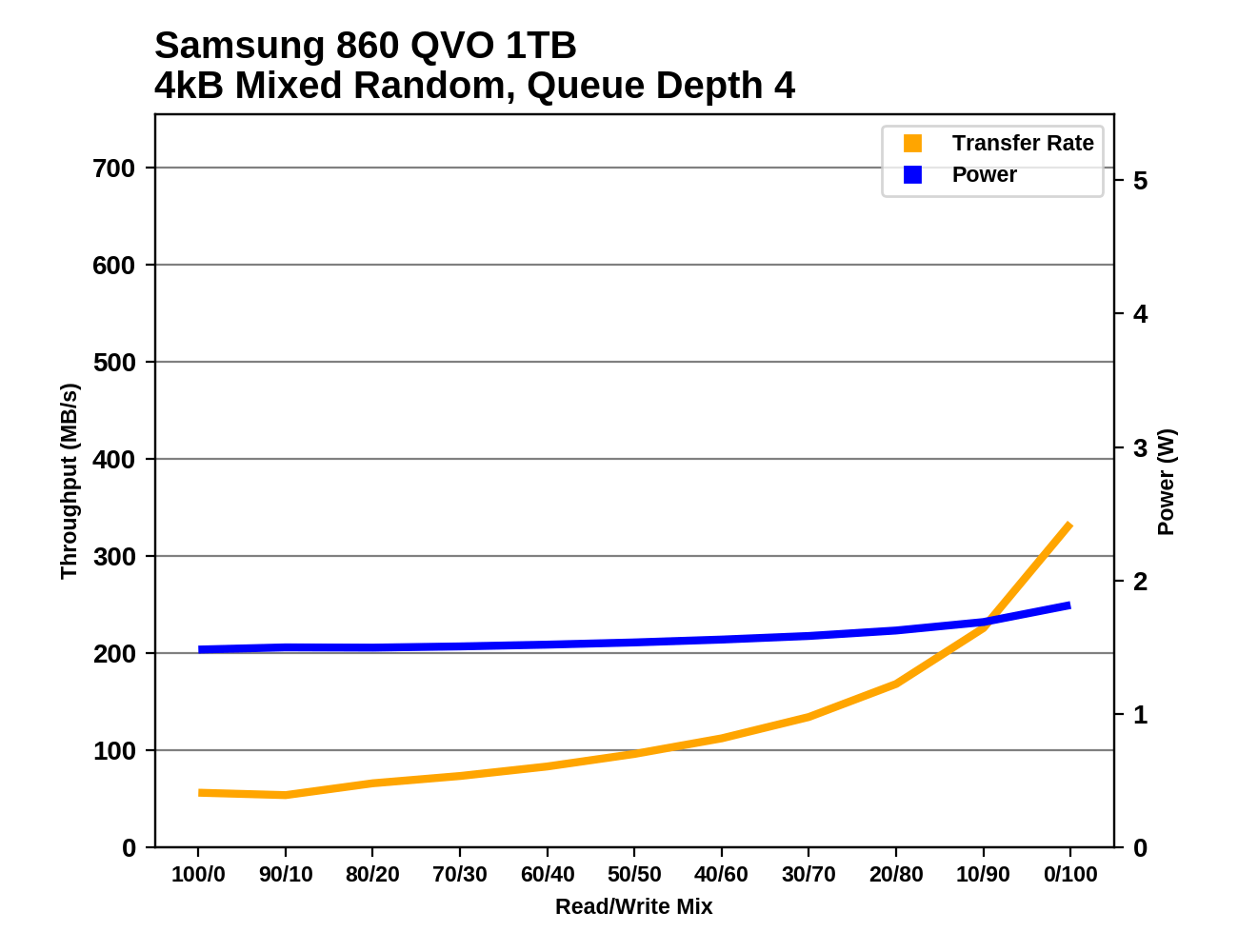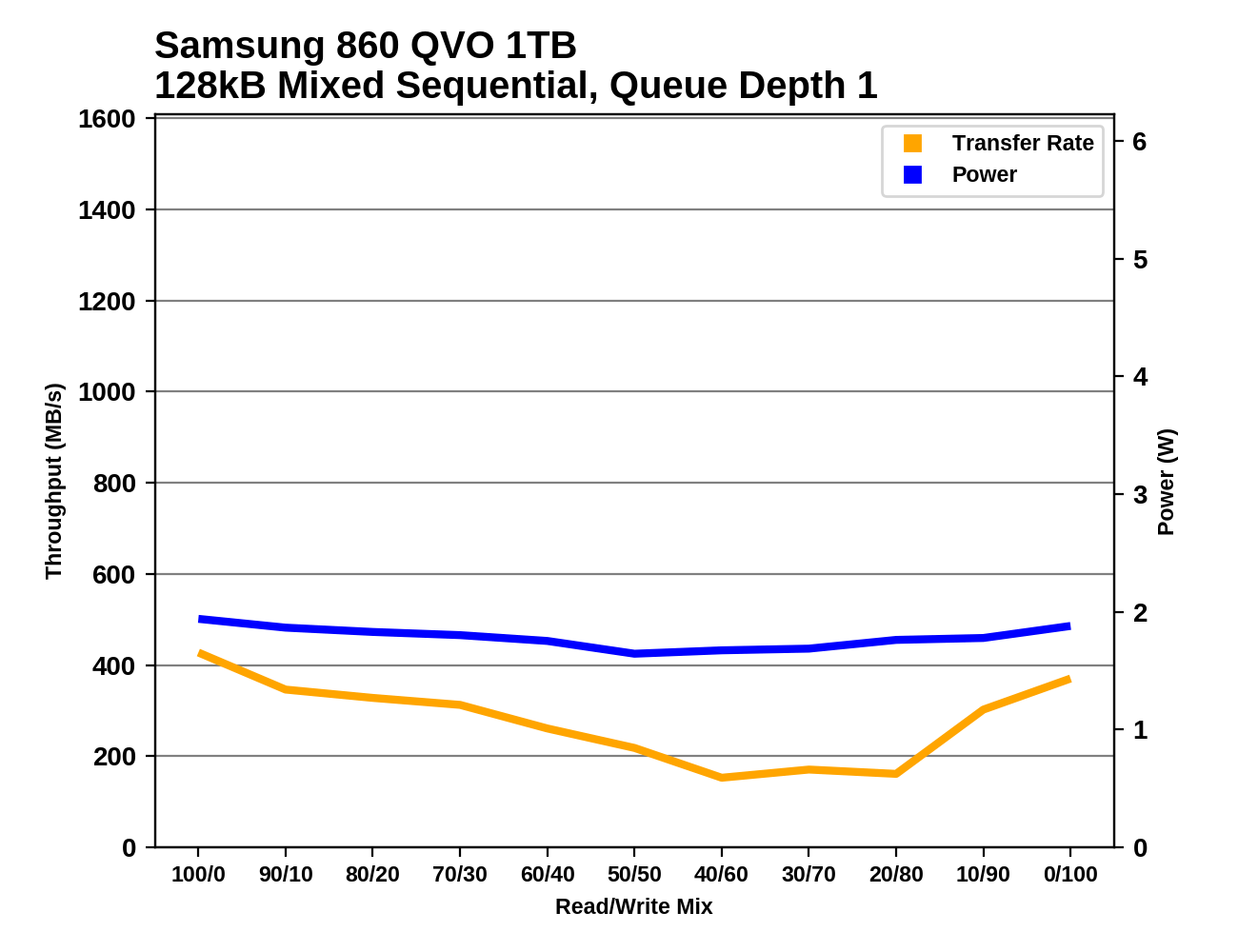The Samsung 860 QVO (1TB, 4TB) SSD Review: First Consumer SATA QLC
by Billy Tallis on November 27, 2018 11:20 AM ESTMixed Random Performance
Our test of mixed random reads and writes covers mixes varying from pure reads to pure writes at 10% increments. Each mix is tested for up to 1 minute or 32GB of data transferred. The test is conducted with a queue depth of 4, and is limited to a 64GB span of the drive. In between each mix, the drive is given idle time of up to one minute so that the overall duty cycle is 50%.

The Samsung 860 QVO's performance on the mixed random I/O test is substantially slower than the 860 EVO, but it is not far behind some of the other mainstream TLC drives. Running the test on a full drive does slow the 1TB 860 QVO down significantly, but it remains faster than the DRAMless TLC drive.
 |
|||||||||
| Power Efficiency in MB/s/W | Average Power in W | ||||||||
The power efficiency rankings for the 860 QVO aren't much better than the raw performance rankings. Power consumption is generally a bit higher than the 860 EVO but doesn't vary much with capacity or state of fill, so the efficiency scores are largely reflective of the performance variations.
 |
|||||||||
The 860 QVO starts out with a fairly slow random read speed but steadily speeds up as the workload shifts toward writes, eventually catching up to the 860 EVO. When the test is run on a full drive, the 1TB 860 QVO runs out of SLC cache in the final few phases of the test and slows down instead of continuing to speed up.
Mixed Sequential Performance
Our test of mixed sequential reads and writes differs from the mixed random I/O test by performing 128kB sequential accesses rather than 4kB accesses at random locations, and the sequential test is conducted at queue depth 1. The range of mixes tested is the same, and the timing and limits on data transfers are also the same as above.

The 4TB 860 QVO handles the mixed sequential I/O test well, but the 1TB model ends up slightly slower than the DRAMless TLC drive and well behind the mainstream TLC drives.
 |
|||||||||
| Power Efficiency in MB/s/W | Average Power in W | ||||||||
The power efficiency scores vary more among the SATA drives than the raw performance scores, so the 860 EVO and Toshiba TR200 stand out as particularly efficient while the 860 QVO 4TB is merely average and the 1TB model is struggling a bit.
 |
|||||||||
Both capacities of the 860 QVO offer decent performance at either end of the test with pure reads or pure writes, and they are unsurprisingly at their worst with the more write-heavy mixes. The 1TB 860 QVO loses far more performance across the first two thirds of the test, but catches back up with the 4TB model at the end.










109 Comments
View All Comments
Santoval - Wednesday, November 28, 2018 - link
"Right now there is exactly zero reason to choose it over the EVO. The 500GB EVO costs about $130 US where I'm from, there's very little incentive for me to buy it given the "inflated" price."Assuming the 500GB EVO actually costs as much as the 1TB EVO in your country (I'm frankly skeptical about this, but let's take you at your word) what makes you thing that the 1TB QVO will not in turn cost as much as the 2TB QVO?
Are you seriously suggesting that your country's taxmen or tariffmen are going to place much lower taxes/tariffs on QLC based SSDs than one TLC based SSDs?
Lolimaster - Thursday, November 29, 2018 - link
Import the 1TB from Amazon, you can do that to any south american country.Impulses - Thursday, November 29, 2018 - link
Even at 25% cheaper than an EVO it would barely beat the (current) best sale price of other mainstream TLC SSD... And TLC is probably not going away any time soon. I'd love to see the price gap reach 25%+ sooner rather than later tho.Oxford Guy - Tuesday, November 27, 2018 - link
It may be that companies are hoping for higher margin. It is not impossible for that to happen. CDs, for example, were a higher margin product than the LPs they replaced.If supply of TLC shrinks, as companies move to QLC production, the competition between TLC and QLC also shrinks, making room, potentially, for more margin.
Amandtec - Tuesday, November 27, 2018 - link
The yields are poor at the moment so there is no point selling them low. It has a big effect on your share price if you release new game changing technology like QLC to market, because shareholders are sophisticated and understand the long term term strategy here.moozooh - Wednesday, November 28, 2018 - link
> The yields are poor at the moment so there is no point selling them low.I think you misunderstand: there's no point *buying them high*. The only point of these drives is buying them low. So not selling them low means *not selling them*, period.
Customers may not be shareholders, but they aren't idiots, either. They understand QLC is a step down in almost every aspect of the drive's operation. It's an inferior product, and the price needs to reflect that for it to be considered for purchase.
jjj - Wednesday, November 28, 2018 - link
Actually , R&D is surprisingly low compared to the revenue generated and, aside from that, they might be close enough to 5 cents per GB production costs now for QLC so if there is a global economic crash caused by Trump and his tariffs, we could see 50$ per TB in half a year from now.Otherwise, could be 2020-2021 for that kind of price, especially if China manages to ramp output.
NAND prices are down a bit from peak but folks still have 40-50% overall NAND margins,there is room for much lower prices and production costs decline 15-25% per year.
R0H1T - Wednesday, November 28, 2018 - link
>they might be close enough to 5 cents per GB production costs now for QLCSure but that's at least 6~12 months away from now. So how can anyone realistically expect Samsung to debut the QVO at such prices given there's no competition (SATA QLC) nor any reason for Samsung to not make hay while the sun shines? For anyone who says the $130 US for 1TB EVO is the normal price, it's not in the ROTW.
sonny73n - Wednesday, November 28, 2018 - link
“Yeah no one's selling you 8TB for $400 anytime soon. Aside from the fact that the R&D costs for QLC need to be recuperated first & companies need to reinvest an increasing amount for future development, there's also a point after which it doesn't make sense for the SSD, or NAND, maker to sell these at a loss.If you really want something that big, for dirt cheap, try spinners instead.”
You sound like a Samsung shill. If HDD manufacturers decide to keep on R&D for those spinners, are you willing to pay extra for their future development? Beside, SSD tech has been around for a decade, now it costs less to make an SSD than to make an HDD for the same capacity.
R0H1T - Wednesday, November 28, 2018 - link
>You sound like a Samsung shill.Oh sure let's all forget the aftermath of the Thai floods ~ insane prices, insane quality (as in really bad) w/warranties as low as just a year long! So while the HDD makers sat on their collective behind, much like Intel, the SSD makers out paced them, out innovated(?) them & could make spinners virtually obsolete, except bottom of the barrel 5400/5900 rpm drives especially in $/GB.
So let's see, arguing for higher prices because R&D is an ever increasing (one time) cost that needs to be recuperated, is shilling now? Do you also want me to feel sad because vacuum tubes are dead or that NAND prices will continue to fall, in the foreseeable future?